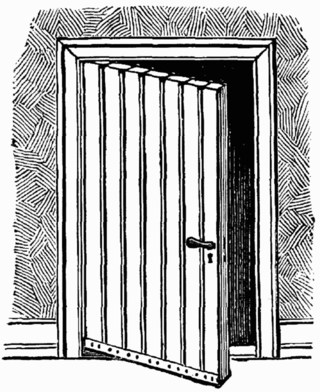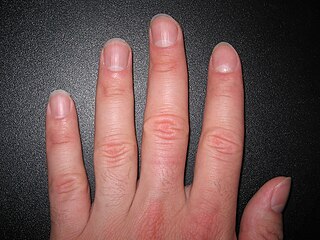
A fingerplate also known as a pushplate, is a plate that is fixed to a door near the handle or keyhole. It can be made of metal, plastic, ceramic or glass. Its purpose is to prevent people's fingers from smudging the door. [1]

A fingerplate also known as a pushplate, is a plate that is fixed to a door near the handle or keyhole. It can be made of metal, plastic, ceramic or glass. Its purpose is to prevent people's fingers from smudging the door. [1]

A door is a hinged or otherwise movable barrier that allows ingress (entry) into and egress (exit) from an enclosure. The created opening in the wall is a doorway or portal. A door's essential and primary purpose is to provide security by controlling access to the doorway (portal). Conventionally, it is a panel that fits into the doorway of a building, room, or vehicle. Doors are generally made of a material suited to the door's task. They are commonly attached by hinges, but can move by other means, such as slides or counterbalancing.

A rotary dial is a component of a telephone or a telephone switchboard that implements a signaling technology in telecommunications known as pulse dialing. It is used when initiating a telephone call to transmit the destination telephone number to a telephone exchange.

A nail is a protective plate characteristically found at the tip of the digits of all primates, corresponding to the claws in other tetrapod animals. Fingernails and toenails are made of a tough rigid protein called alpha-keratin, a polymer also found in the claws, hooves and horns of vertebrates.

The fastball is the most common type of pitch thrown by pitchers in baseball and softball. Its distinctive feature is its high speed. "Power pitchers," such as former American major leaguers Nolan Ryan and Roger Clemens, rely the speed of the fastball to prevent the ball from being hit and throw fastballs at speeds of 95–105 miles per hour (153–169 km/h) (officially) and up to 108.1 miles per hour (174.0 km/h) (unofficially). As an alternative to the fastball, pitchers can put movement on slower thrown balls, or throw them towards the inside or outside of home plate where batters cannot easily reach it.

A changeup is a type of pitch in baseball and fastpitch softball.
Fingerplate or finger-plate may refer to:

A door handle or doorknob is a handle used to open or close a door. Door handles can be found on all types of doors including exterior doors of residential and commercial buildings, internal doors, cupboard doors and vehicle doors. There are many designs of door handle, depending on the appropriate use. A large number of handles, particularly for commercial and residential doors, incorporate latching or locking mechanisms or are manufactured to fit to standardised door locking or latching mechanisms.

A gauntlet is a type of glove that protects the hand and wrist of a combatant. Gauntlets were used particularly in Europe between the early fourteenth century and the early modern period and were often constructed of hardened leather or metal plates.

A finger joint, also known as a comb joint, is a woodworking joint made by cutting a set of complementary, interlocking profiles in two pieces of wood, which are then glued. The cross-section of the joint resembles the interlocking of fingers between two hands, hence the name "finger joint". The sides of each profile increases the surface area for gluing, resulting in a strong bond, stronger than a butt joint but not very visually appealing. Finger joints are regularly confused with box joints, which are used for corners of boxes or box-like constructions.

A subungual hematoma is a collection of blood (hematoma) underneath a toenail or fingernail. It can be extremely painful for an injury of its size, although otherwise it is not a serious medical condition.

Finger foods are small, individual portions of food that are eaten out of hand. They are often served at social events. The ideal finger food usually does not create any mess, but this criterion is often overlooked in order to include foods like tacos. One origin for finger foods is the French canapé.

The interphalangeal joints of the hand are the hinge joints between the phalanges of the fingers that provide flexion towards the palm of the hand.

The Design of Everyday Things is a best-selling book by cognitive scientist and usability engineer Donald Norman about how design serves as the communication between object and user, and how to optimize that conduit of communication in order to make the experience of using the object pleasurable. One of the main premises of the book is that although people are often keen to blame themselves when objects appear to malfunction, it is not the fault of the user but rather the lack of intuitive guidance that should be present in the design.

In the human hand, palmar or volar plates are found in the metacarpophalangeal (MCP) and interphalangeal (IP) joints, where they reinforce the joint capsules, enhance joint stability, and limit hyperextension. The plates of the MCP and IP joints are structurally and functionally similar, except that in the MCP joints they are interconnected by a deep transverse ligament. In the MCP joints, they also indirectly provide stability to the longitudinal palmar arches of the hand. The volar plate of the thumb MCP joint has a transverse longitudinal rectangular shape, shorter than those in the fingers.

Mr. Monk Goes to Germany is the sixth novel by Lee Goldberg to be based on the television series Monk. It was published on July 1, 2008.
Kokkuri or Kokkuri-san (こっくりさん) is a Japanese game popular during the Meiji era that is also a form of divination, partially based on Western table-turning. The name kokkuri is an onomatopoeia meaning "to nod up and down", and refers to the movement of the actual kokkuri mechanism. The kanji used to write the word is an ateji, although its characters reflect the popular belief that the movement of the mechanism is caused by supernatural agents. The modern version is similar to a Ouija board.

The Museo dell'Opera del Duomo in Florence, Italy is a museum containing many of the original works of art created for Florence Cathedral, including the adjacent Florence Baptistery and Giotto's Campanile. Most of the exterior sculptures have been removed from these cathedral buildings, usually replaced by replica pieces, with the museum conserving the originals.

Millwork is historically any wood mill produced decorative materials used in building construction. Stock profiled and patterned millwork building components fabricated by milling at a planing mill can usually be installed with minimal alteration. Today, millwork may encompass items that are made using alternatives to wood, including synthetics, plastics, and wood-adhesive composites.

Piring dance is a traditional Minangkabau plate dance originated and performed in West Sumatra, Indonesia. It is also performed in Negeri Sembilan, Malaysia. The dance might be performed by a group of women, men, or couples; each of whom holds a plate in each hand, and vigorously rotates or half rotates them in various formations and fast movements.